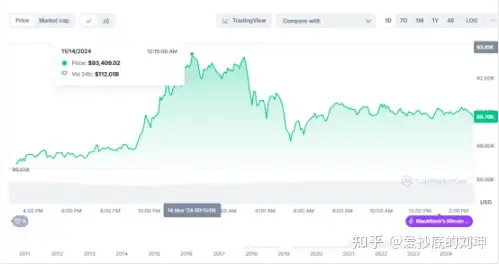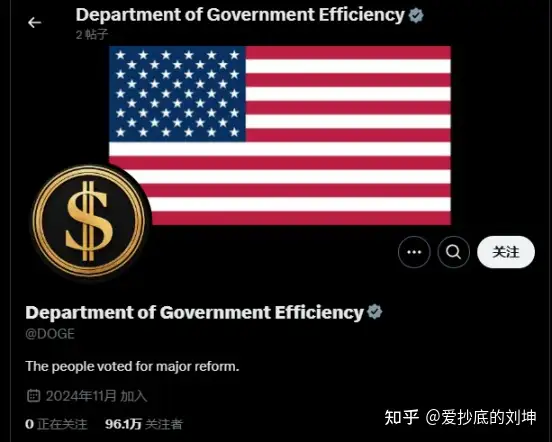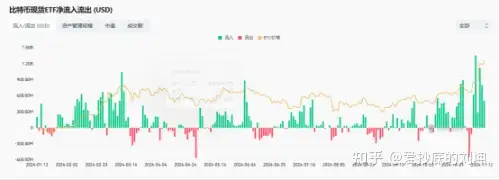Bitcoin went from $70,000 to $90,000 in just one week. Just this morning, Bitcoin hit a new high, rising all the way to break through the $90,000 mark, reaching a high of over $93,000, just one step away from the $100,000 predicted by analysts.
The raging bull market is emerging, the crypto world is boiling, and the news is also burning. Can this trend continue? How far can the Trump effect go? The market is also full of different opinions.
Before the election, Bitcoin surged to $74,000, and at the time the market still had doubts, with bearish and conservative voices, but the facts have proven that the Trump effect is more worth expecting than imagined.
This morning, Bitcoin rose nearly 6% during the day, officially standing at $90,000, reaching a high of $93,462, although it later fell back to $90,000, but as of now, Bitcoin has risen more than 33% since the US election. And after breaking through $93,000, Bitcoin's market value briefly rose to $1.84 trillion, surpassing Saudi Aramco and temporarily ranking 7th among the world's mainstream assets.

The crypto market is also boiling, with the USDT market value breaking through $127.84 billion, setting a new high, and the mainstream sectors generally rising, with new coins such as PUNT in the MEME sector continuing to surge. In the early morning, US stocks and crypto-currency concept stocks collectively rose, with MicroStrategy up more than 4%, Coinbase up 3.7%, and Riot Blockchain up 2%, while the crypto sector in the Hong Kong stock market also continued to rise, with Huobi Tech up more than 10%.
The same volatility brings the same recipe for liquidation. Coinglass data shows that as of this morning, the 24-hour crypto market had a total of $659 million in contract liquidations, of which $374 million were long liquidations and $284 million were short liquidations. The total amount of BTC liquidations was $161 million, and the total amount of ETH liquidations was $87.1368 million.
As for the reasons for the rise, the Trump agenda and the outlook for Federal Reserve policy are the main positive factors, but on the other hand, the bullish sentiment of large institutions and the trend of national reserve currency are also important reasons.
From the Federal Reserve's perspective, after the 25BP rate cut in November, lowering the federal funds rate to 4.5%-4.75%, the market is generally cautious about further rate cuts, especially given the obvious inflationary risks in Trump's policy ideas. However, the CPI data released yesterday made rate cuts more feasible. The data released on Wednesday showed that the US CPI rose 2.6% year-on-year in October and 0.2% month-on-month; the core CPI (excluding volatile factors such as energy and food) rose 3.3% year-on-year and 0.3% month-on-month, indicating that the October non-farm payrolls were disrupted by hurricanes but in line with expectations of inflation.
Against this backdrop, traders have increased their bets on the Federal Reserve cutting rates further next month. According to the CME Fed Watch, the probability of the Federal Reserve keeping the current rate unchanged in December is 17.5%, and the probability of a cumulative 25 basis point rate cut is 82.5%. The probability of keeping the current rate unchanged in January next year is 11.9%, the probability of a cumulative 25 basis point rate cut is 61.7%, and the probability of a cumulative 50 basis point rate cut is 26.5%.
The loose environment seems to be able to continue, and the prices of risky assets are pushed up accordingly. But what is more noteworthy is that the current rise in the crypto market is undoubtedly highly dependent on the expected regulatory benefits brought by Trump.
As a new president, Trump needs to nominate 15 cabinet members, and those highly related to crypto are undoubtedly Musk and Robert Kennedy. Although Robert Kennedy has not yet taken office, the boots of the Government Efficiency Department have already fallen. Trump announced that Musk and Vivek Ramaswamy will jointly lead the proposed "Government Efficiency Department", and stated that the agency will pave the way for dismantling the government bureaucracy, reducing redundant regulatory rules and wasteful spending, and restructuring federal agencies.

Musk reposted the appointment on social media, saying that the Government Efficiency Department is a threat to bureaucracy, not democracy. The efficiency of the Government Efficiency Department is also lightning fast, as the official X account of the Government Efficiency Department has already gone online today, and Musk's support for crypto is no less, as he not only released a LOGO with the DOGE logo, but also @DOGE on the official account, which also added fuel to the DOGE community.
On the SEC side, which the market is most concerned about, from a regulatory perspective, the president cannot remove Gensler from the commission without just cause, and Gensler himself also seems to have no intention of resigning. But for the Senate candidates, Trump has given some hints, saying he will bypass the Senate confirmation process to appoint his government members, and if this statement is true, the probability of Gensler's position being unsecured will be greatly increased. On the other hand, the Senate Majority Leader next year will be Senator John Thune, who supports crypto legislation, which has laid a solid foundation for a positive policy direction.
Although from the agenda Trump has currently announced, the first day's work will start with the relatively easy-to-implement large-scale deportation of illegal immigrants residing in the US, crypto is not on the list, but with the continued addition of pro-crypto members to the ruling party, the long-term certainty of positive factors is clearly visible, such as the legal counsel of Ripple, which has been heavily impacted by regulation, believes that the new government will withdraw the digital asset cases, and the market sentiment is accordingly turbulent.
Unexpectedly, large institutions are also giving real support. MicroStrategy took the lead, announcing on the evening of November 11 that it had purchased 27,200 Bitcoins between October 31 and November 10 at a cost of about $2.03 billion, with an average purchase price of about $74,463 per Bitcoin. The funds for this purchase came from the company's ATM stock sales. Currently, MicroStrategy's total holdings have reached 279,420 Bitcoins, with a total purchase cost of about $11.9 billion and an average purchase price of about $42,692 per Bitcoin.
Wall Street is also not to be outdone, and after the US election, the net inflows of Bitcoin ETFs and Ethereum ETFs have soared. The US Bitcoin spot ETF has seen net inflows for 6 consecutive days, with a total inflow of $4.705 billion and a total asset management scale of $56.475 billion and a total market value of $95.688 billion. The Ethereum spot ETF is slightly inferior, but has also seen net inflows of over $759 million in the past 6 days.

It is clear that institutions are showing a bullish sentiment on Bitcoin, to the extent that they are making large-scale purchases at the current price, which can be considered high. It is worth mentioning that the large-scale purchases by institutions have also provided price support for Bitcoin. Analysts also point out that the current cost basis of new investors or short-term investors is around $66,800.
Furthermore, the Bitcoin US reserve asset proposed by Trump has been gradually implemented in other countries. The pioneering El Salvador and Bhutan have already reaped substantial benefits, and taking Bhutan as an example, the government of the Kingdom of Bhutan with a population of less than 800,000 holds 12,576 Bitcoins, worth over $1.1 billion, making it the fourth largest government Bitcoin holder in the world, with the total value of its Bitcoin holdings exceeding 25% of the country's total GDP. Lawmakers in Venezuela and Germany have also proposed including Bitcoin in the national reserve. And recently, Bitcoin Magazine CEO David Bailey revealed on social media that at least one sovereign nation is actively acquiring Bitcoin and has already ranked among the top five holders. The identity of this sovereign nation has not been disclosed, but the market largely speculates that it is the cash-rich Qatar and Saudi Arabia, as relatively economically backward regions would find it difficult to support such a large amount of funds at the current price.
With a variety of positive factors, it is not surprising that Bitcoin is advancing rapidly. In a bull market, any bullish factors can drive its continuous rise, and the same is true for its decline. However, it is evident that Trump remains the main driver of this bull market, and therefore, his subsequent policies will be closely watched, which also brings uncertainty to the market.
Although he has already gained control of Congress, after taking office, Trump's top priority will inevitably be on economic and fiscal policies, and the priority of the crypto industry will continue to be pushed back. The more direct action would be the dismissal of the SEC chairman, as Trump has mentioned that he will dismiss Gensler upon taking office, and will also establish a presidential advisory council on Bitcoin and cryptocurrencies. This action may be a direct short-term indicator that can be observed quickly after January 20th.
As for the highly anticipated US reserve asset, it is just an ideal that is far from reality. On the one hand, the high volatility of Bitcoin does not meet the principle of strategic reserves; on the other hand, at the implementation level, the inclusion of Bitcoin in the national reserve still faces legal, security, and traditional institutional obstacles, as the regulatory framework for Bitcoin is not yet clear, and any changes in classification, custody, or taxation will lead to major changes in existing regulations, and even pose security risks. Even if the regulations are improved, the erosion of the Fed's independent policy by decentralized currency will also provoke opposition from the central bank, not to mention the adaptability issues of traditional financial institutions and other vested interests. Some have also suggested that Trump is not targeting Bitcoin, but rather seeking riskless arbitrage through the coordination of stablecoins and Bitcoin, but this remains unproven and is currently just speculation.
Of course, despite the many obstacles, the potential benefits of actually implementing it would be huge. Renowned cryptocurrency investor Novogratzy has predicted that if implemented, Bitcoin would soar to $500,000, and ArthurHayes even believes it could reach $1 million in the future.
Nevertheless, given Bitcoin's current upward trend, the $100,000 that many analysis agencies believe is only a step away, and Morgan Chase has also stated that Bitcoin will continue to benefit from the Trump effect in the next 8 weeks, while CNBC and Copper both believe that Bitcoin can reach $100,000 before the presidential inauguration.
It is worth noting that for short-term investors, a correction after a sharp rise is normal. Glassnode's analysts believe that Bitcoin has entered a price discovery phase, and historically, such phases last an average of about 22 days, after which a major correction will occur, during which about 5% of the circulating supply may be pushed down below the original purchase price. Currently, it has been in a high-profit position for 12 consecutive days.
But based on the current situation, the expectation still has support, and the correction before Trump's formal inauguration will be relatively limited.






